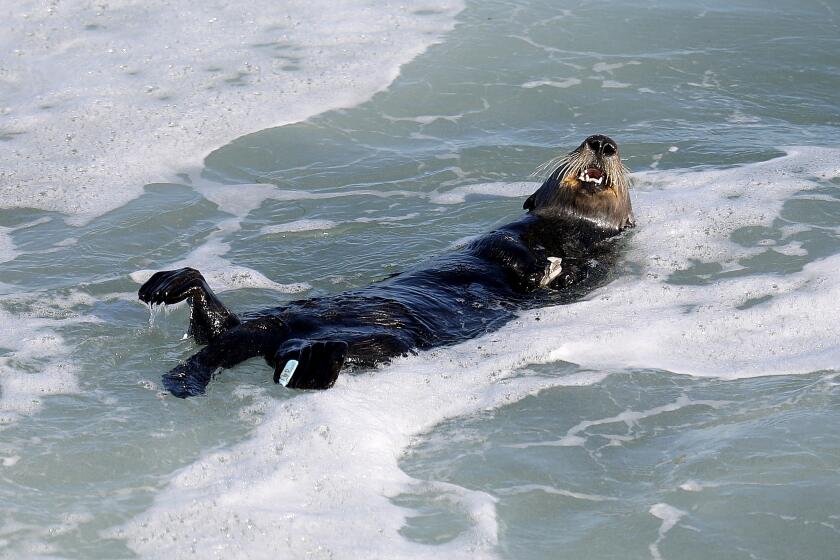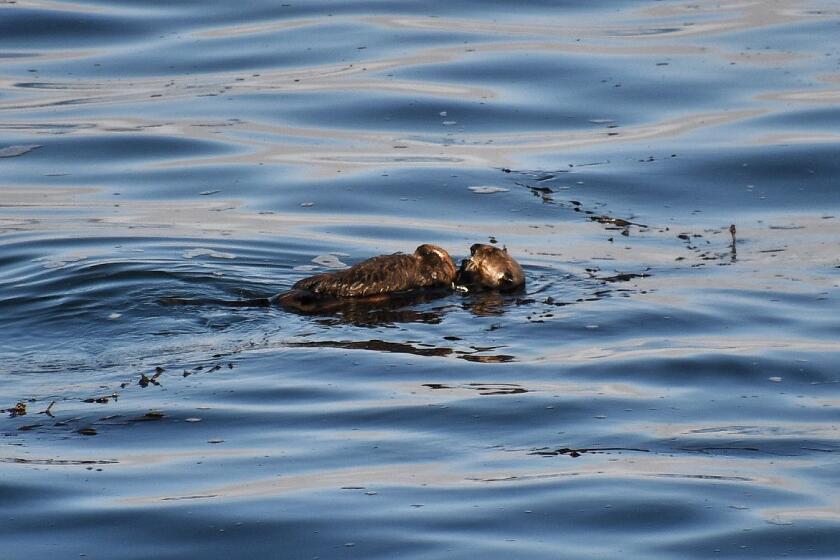Is the restoration of California’s cutest keystone species worth it?

- Share via
Sea otters are terminally cute critters and a delight to view rolling and diving in the kelp canopy of Monterey Bay, where some 3,000 endangered southern otters play an essential role in maintaining the marine kelp forest. But to crabs, clams, abalone, urchins and some fishermen, sea otters are voracious marine weasels that can eat 25% of their body weight a day — a perceived threat to life and livelihood.
That’s why some lively debates were launched at 16 open houses put on by the U.S. Fish and Wildlife Service last year to get public input on, as the invitation put it, the “potential reintroduction of sea otters to their historic range,” including Oregon and Northern California, a decision that is expected to be made this year.
As authorities extend their dragnet over land, sea and air, the renegade sea otter known as ‘841’ continues to evade capture while snacking on shellfish.
In 2020, the service was directed by Congress to study the feasibility and cost of otter repopulation in part because of fear that an oil spill or other incident could wipe out the group concentrated around Monterey Bay. In September 2023, U.S. Fish and Wildlife rejected a fishing industry petition to remove otters’ threatened status under the Endangered Species Act because the California population has failed to grow significantly in recent decades.
There was an added incentive to keep the protection in place: the ongoing marine havoc linked to climate change. An algal bloom off the Central California coast killed hundreds of sea lions and dolphins last summer, multiple “red tides” have invaded San Francisco Bay and nearly 95% of Northern California’s kelp forest has been decimated by small purple sea urchins whose primary predator (with the sea otter out of the picture) — the sunflower sea star, or starfish — has largely died off from a wasting disease caused or exacerbated by warming ocean temperatures.
Santa Cruz’s sea otter, 841, has given birth to a wee pup — suggesting that her erratic behavior could have been hormonally driven.
Once upon a time, vast rafts of hundreds of thousands of sea otters filled the coastal waters of the north Pacific Rim, from Baja to Japan, until they were driven to near extinction by Captain Cook and other 18th and 19th century British, Russian and American fur-trade hunters, who killed “sea beavers” to supply the Chinese imperial court with luxurious otter fur. Remnant populations were protected starting in 1911. In California in the early 1960s, survivors from around Big Sur recolonized Monterey Bay, feasting on urchins that eat kelp and revitalizing the kelp forest. A small group has even migrated south close to Santa Barbara.
Now environmentalists in Oregon and California, and several Indigenous groups, including the Kashia Band of Pomo Indians in Sonoma County, are mobilizing in support of an attempt to restore otters where they’ve long been absent, including San Francisco Bay. Fishermen are not so sanguine.
Federal wildlife officials have taken the first step toward potentially reintroducing sea otters to their former habitats in Northern California and Oregon.
At the Bodega Bay open house, an abalone diver, Doug Jung, summarized fishermen’s worries succinctly: Wouldn’t reintroduced otters “strip mine the ocean”?
Dick Ogg, a longtime fisherman, was more specific. “The potential for impact,” he said, “can’t be quantified. If they eat the juvenile crab, that could be a big deal. Dungeness crab is our No. 1 fishery.”
There was no California salmon season in 2023 because of the long drought that preceded last winter’s torrential rains, and the 2024 season is still in question. As for recreational abalone diving on the North Coast, it’s been shut down since the kelp forest collapsed (commercial abalone diving was banned long ago). Things are precarious all around for West Coast commercial fishermen, who worry about maintaining their working waterfronts.
“I still think nature will do its own work,” Ogg told the Fish and Wildlife representatives in Bodega Bay. “I wouldn’t be bothered if [otters] recolonized on their own.”
Kelp forests north of the Golden Gate are in dire shape. The return of the sea otter could help bring them back to life.
But natural repopulation from the Golden Gate north isn’t likely. With the decline of protective coastal kelp and a now-healthy population of white sharks in the region’s waters, migrating otters stand a good chance of becoming great white snack food. But with human assistance, the reintroduction of otters could bypass the gauntlet.
If the effort succeeded, the impact on fishing might not be what is feared.
A 2020 study in the journal Science found that Canada’s reintroduction of sea otters in British Columbia not only generated $42 million from otter-loving tourists but also added $9 million to the commercial fishery thanks to its restoration of kelp habitat for lingcod and other species. Alaska, where released sea otters helped repopulate the coastal waters in the 1960s, now has both the largest number of otters and the most productive commercial fishery in the U.S.
“The sea otter could very well be the salvation for … catching fish in the years ahead if we can rebuild and repair a healthy ecosystem,” suggests Rep. Jared Huffman (D-San Rafael), whose congressional district includes the entire coast north of San Francisco.
In Oregon and Northern California, there is hope that the cascading imbalances human have caused — exterminated otters, sick sea stars, disappearing abalone — can begin to be set straight, and that the kelp forest habitat, rich in marine life and a buffer against torrential storms, can recover.
And yes, we need to restore many more creatures in many more habitats and ecosystems. Maybe an adorable marine weasel can motivate that, too.
David Helvarg is executive director of Blue Frontier, an ocean policy group, and co-host of “Rising Tide: The Ocean Podcast.”
More to Read
A cure for the common opinion
Get thought-provoking perspectives with our weekly newsletter.
You may occasionally receive promotional content from the Los Angeles Times.












